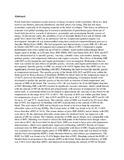| dc.description.abstract | Fossil fuels have remained crucial sources of energy for most world economies. However, their reserves are limited, unevenly distributed, and their prices ever rising. This has left many economies, especially in developing countries in the brink of collapse. This factor, in addition to concerns over global warming due to excessive production of green house gases from use of fossil fuels has led to a search of alternative, sustainable and environment fiiendly sources of energy. In the present study, the suitability of use of Jatropha Methyl Ester and its blends with grade No.2 diesel fuel (DF2) as an alternative fuel for compression ignition engines was investigated. Jatropha oil was transesterified using base-catalyzed transesterification process to Jatropha Methyl Ester (JME). The fuel properties and characteristics of pure JME (B 1 00) and its blends with DF2 were investigated and compared to those of DF2. Comparative engine performance tests were carried out on a Ford 6- cylinder, water-cooled turbo-charged diesel engine rated at 86 bhp, at 2250 rpm.
Pure JME (BI00), DF2 and blends B20, B35, B50, and B75 were characterized as to specific gravity, viscosity, calorific value, acid number, heating value, ignition quality, cold temperature behaviour and copper corrosion. The effects of blending JME with DF2 on fuel properties and engine performance were investigated. Preheating of the test fuels was carried out and effects on specific gravity, viscosity and engine performance were also investigated. Specific gravity of JME was found to be 4.83% higher than that ofDF2, but was significantly lowered upon blending with DF2. Preheating the fuels lowered the specific gravity as temperature increased. The specific gravity of the blends B20, B35 and B50 were within the limits given by Kenya Bureau of Standards (KEBS) for diesel fuels for the temperature range of 15-60°C; however the blends B75 and B 100 required preheating. Correlation models were developed to predict the specific gravity of the test fuels as function of both temperature and amount of JME in the blend. The viscosity of B 1 00 was found to be 42.0<)0/0 higher than that of DF2. Blending JME with DF2 resulted in significant viscosity reduction, which varied linearly with the amount of DF2 in the blend and polynomially with increase in temperature for all the tested fuels. A correlation model was developed to approximate the viscosity of any blend for the temperatures in the range from 15°C to 60°C. The viscosity of B20 was within specified limits for temperatures of up to 42°C, that of B35 and B50 for up to 46°C, while that ofB75 and B 1 00 for up to 53° and 55°C, respectively.
The calorific value of JME was found to be 8% lower than that of DF2, but improved on blending with DF2 in proportion to the amount of DF2 in the blend. The acid values of JME and its blends were found to be lower than the maximum allowable values of 0.8 mg KOHlg. The Cetane index of JME was found to be 45.38, 13.96% lower than that ofDF2 of 54.42. The cetane indices of pure JME (BlOO) and its blends with DF2 were above 40, the minimum allowable cetane index for biodiesel fuels, but improved with amount of DF2 in a blend. The volatility properties of JME and its blends were comparable with those of DF2. Blending was found to reduce the flash point of the blended fuels though values were above 60°C, the lower limit for diesel fuels. JME was found to have poor cold temperature characteristics, which were significantly improved on blending with DF2. Results of Copper corrosion tests for JME and the blends were comparable with those of DF2.
Engine performance was evaluated at a constant engine speed of 1500 RPM at various loads and was based on brake specific fuel consumption (BSFC), brake thermal efficiency and exhaust gas temperatures. The BSFC for JME was found to be 15.43% higher than that of DF2. Blending reduced the BSFC of blended fuels in proportion to the amount ofDF2 in the blend. Brake thermal efficiency of JME was 5.48% lower than that ofDF2, and improved on increasing the amount of DF2 in blended fuels. Preheating of B 100 lowered its viscosity to that of DF2 but did not improve either BSFC or brake thermal efficiency. Exhaust gas temperatures for all the fuels were comparable.
The study established that Jatropha Methyl Ester and its blends with DF2 have fuel properties and characteristics comparable to those of DF2. Engine performance tests showed that JME and its blends with DF2 were slightly inferior compared with DF2 in performance in unmodified diesel engine. It was concluded that use of blends containing up to 50010 JME resulted in engine performance comparable to that of diesel fuel. | en_US |

